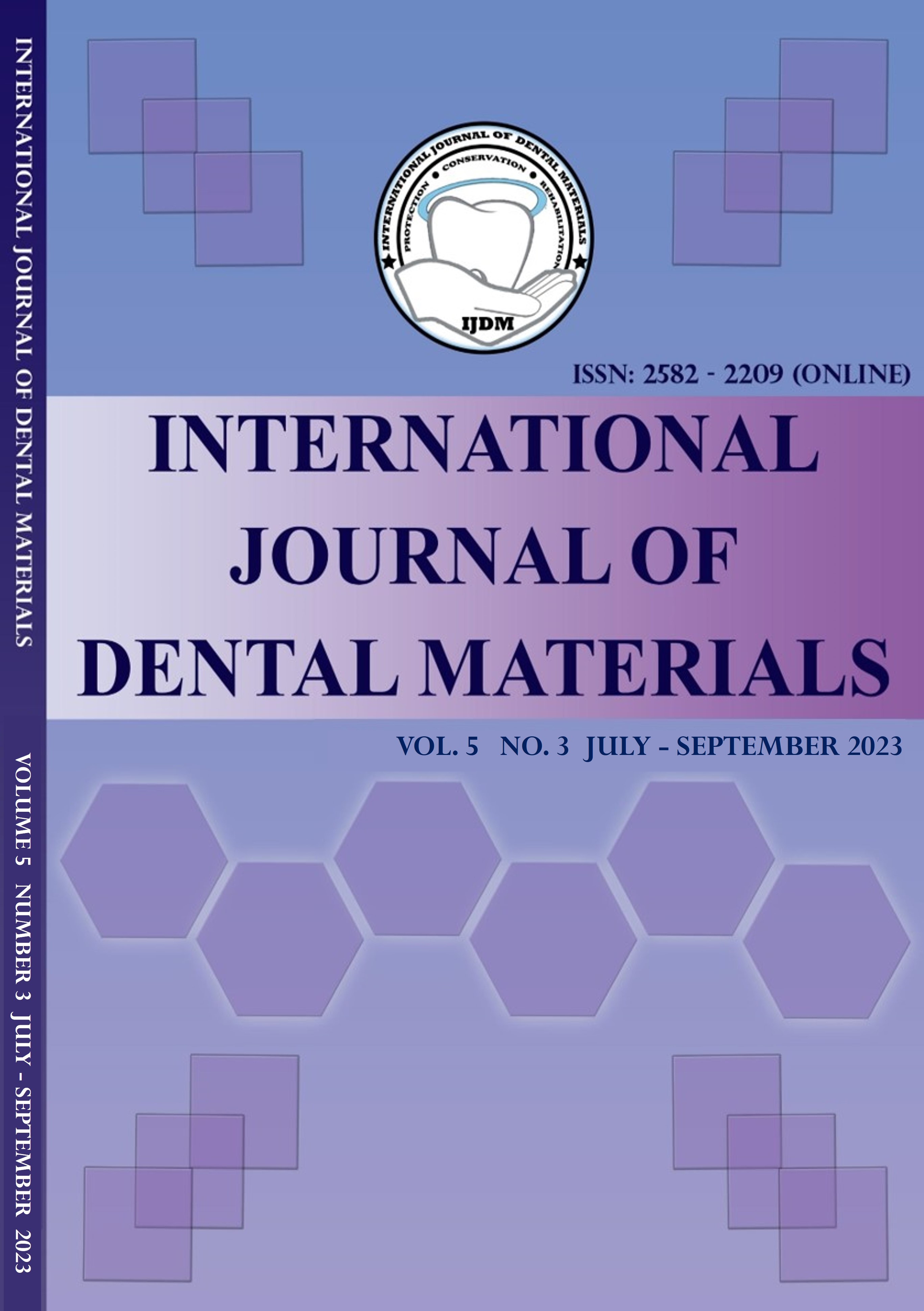Evaluation of radio-morphometric indices of mandible using digital panoramic radiography: a radiographic study
Main Article Content
Abstract
Background: Bone mineral density (BMD) varies with race, ethnicity, age, and gender. Thus arises the need for population-specific value ranges. Qualitative and quantitative indices of the mandible have also been used for panoramic radiographs to assess bone quality and to observe signs of resorption and osteoporosis.
Aim: To measure the radio-morphometric indices in a digital panoramic radiograph and to find the inter-relationship of the indices with the age and sex of the patients.
Materials and Methods: The study included 100 digital panoramic radiographic images of patients, and the samples were divided into four age groups. A panoramic radiograph of each patient was taken, and radio-morphometric indices were determined. Four indices, namely, cortical width at the gonion (GI) and below the mental foramen (MI), Mandibular cortical index (MCI) and Panoramic Mandibular Index (PMI), were measured bilaterally in all panoramic radiographs. All images were analyzed, and index values were calculated by applying linear measurements on the panoramic radiographs.
Results: Statistically significant differences were observed among the study population.
Conclusion: Radio-morphometric indices in a panoramic radiograph may possibly be used as a potential screening tool in identifying individuals with osteoporosis.
Article Details
Section

This work is licensed under a Creative Commons Attribution 4.0 International License.
This work is licensed under a Creative Commons Attribution 4.0 International License.
How to Cite
References
Devlin H, Horner K. Mandibular Radio-morphometric Indices in the Diagnosis of Reduced Skeletal BoneMineral Density. Osteoporosis International. 2002;13:373-378. https://doi.org/10.1007/s001980200042
Bras J, Van Ooij CP, Abraham-Inpijn L, Kusen GJ, Wilmink JM. Radiographic Interpretation of the Mandibular Angular Cortex: A Diagnostic Tool in Metabolic Bone Loss. Part I. Normal state. Oral Surgery, Oral Medicine, Oral Pathology and Oral Radiology. 1982;53: 541-545. https://doi.org/10.1016/0030-4220(82)90473-X
Gulsahi A, Yuzugullu B, Imiralioglu P, Genc Y. Assessment of panoramic radio-morphometric indices in Turkish patients of different age groups, gender and dental status. Dentomaxillofac Radiol 2008; 37: 288-92. https://doi.org/10.1259/dmfr/19491030
Leite AF, Figueiredo PT, Barra FR, De Melo NS, De Paula AP. Relationships between mandibular cortical indexes, bone mineral density, and osteoporotic fractures in Brazilian men over 60 years old. Oral Surg Oral Med Oral Pathol Oral Radiol Endod 2011; 112: 648-56. https://doi.org/10.1016/j.tripleo.2011.06.014
Kiswanjaya B, Yoshihara A, Deguchi T, Hanada N, Miyazaki H. Relationship between the mandibular inferior cortex and bone stiffness in elderly Japanese people. Osteoporos Int 2010; 21: 433-8. https://doi.org/10.1007/s00198-009-0996-9
Dagistan S, Bilge OM. Comparison of antegonial index, mental index, panoramic mandibular index and mandibular cortical index values in the panoramic radiographs of normal males and male patients with osteoporosis. Dentomaxillofac Radiol 2010; 39: 290-4. https://doi.org/10.1259/dmfr/46589325
Hastar E, Yilmaz HH, Orhan H. Evaluation of mental index, mandibular cortical index and panoramic mandibular index on dental panoramic radiographs in elderly. Eur J Dent 2011; 5: 60-7. https://doi.org/10.1055/s-0039-1698859
Seeman E, Martin TJ. Non-invasive techniques for the measurement of bone mineral. Bailliere’s Clin Endocrinol Metab 1989; 3: 1-33. https://doi.org/10.1016/S0950-351X(89)80021-7
Nakamoto T, Taguchi A, Ohtsuka M, et al. Dental panoramic radiograph as a tool to detect postmenopausal women with low bone mineral density: untrained general dental practitioners’ diagnostic performance. Osteoporos Int 2003; 14: 659-64. https://doi.org/10.1007/s00198-003-1419-y
Groen JJ, Duyvensz F, Halsted JA. Diffuse alveolar atrophy of the jaw (non-inflammatory form of paradental disease) and pre-senile osteoporosis. Geront Clin 1960; 2: 68-86. https://doi.org/10.1159/000244610
Manson JD, Lucas RB. A microradiographic study of age changes in the human mandible. Arch Oral Biol 1962; 7: 761-769. https://doi.org/10.1016/0003-9969(62)90125-5
Atkinsodn PJ, Woodhead C. Changes in human mandibular structure with age. Arch Oral Biol 1968; 13: 1453-63. https://doi.org/10.1016/0003-9969(68)90027-7
Sener E, Baksi BG. Evaluation of fractal dimension and mandibular cortical index in healthy and osteoporosis patients. Ege Dent J. 2016;37(3):159–67. https://doi.org/10.5505/eudfd.2016.47550
Arsan B, Kose TE, Cene E, Ozcan I. Assessment of the trabecular structure of mandibular condyles in patients with temporomandibular disorders using fractal analysis. Oral Surg Oral Med Oral Pathol Oral Radiol. 2017;123(3):382–91. https://doi.org/10.1016/j.oooo.2016.11.005

